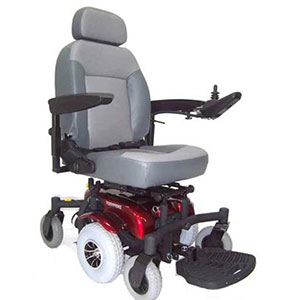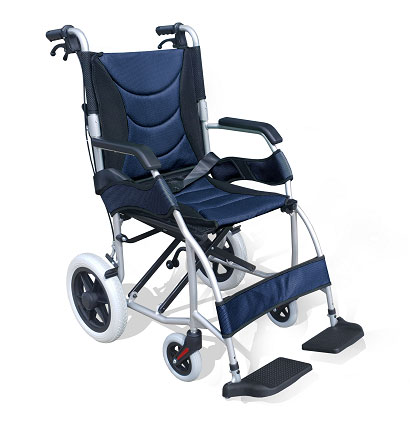Ultimate Guide to Choosing the Right Kind of Wheelchair
Ultimate Guide to Choosing the Right Kind of Wheelchair
Imagine gaining the freedom to navigate your world with confidence, knowing that your wheelchair meets your specific needs, provides unmatched support, and transforms your life for the better. Choosing the perfect wheelchair isn’t just about mobility, it’s about regaining your independence, comfort, and quality of life. But with so many options out there, how do you know which one is right for you or your loved one?
Fear not, because we’re here to help! In this article, we’ll break down the key factors to consider when selecting the ideal wheelchair. Whether you’re navigating the world of wheelchairs for the first time or seeking an upgrade, we’ve got your back.
At Rockingham Kwinana Mobility and Rehabilitation Supplies, we understand that one size doesn’t fit all when it comes to mobility. Our mission is simple: to guide you in making an informed choice that suits your unique needs.

Factors to Consider When Choosing a Wheelchair
When it comes to selecting the perfect wheelchair, there’s no one-size-fits-all solution. Each individual’s needs and circumstances are unique, and it’s essential to take various factors into account.
Mobility Level
The primarily factor to consider when choosing a wheelchair is the individual’s mobility level. This fundamental aspect can make a difference in terms of comfort and independence.
Self-propulsion Capabilities
One of the primary considerations when selecting a wheelchair is the user’s ability to self-propel. For those with sufficient upper body strength and coordination, a manual wheelchair may be the ideal choice. These wheelchairs are designed for self-propulsion, allowing users to move themselves independently. The are generally lighter, more manoeuvrable, and offer an excellent workout for the upper body muscles.
However, it’s essential to assess the user’s physical strength and endurance before opting for a manual wheelchair. Factors like the terrain they’ll be navigating and the distance they’ll need to travel should also be taken into account.
Assistance Required for Pushing the Wheelchair
On the flip side, some individuals may require assistance when it comes to propelling their wheelchair. This assistance can come from a caregiver, family member, or friend. In such cases, a transport wheelchair or a lightweight, easy-to-push manual wheelchair may be more suitable.
Transport wheelchairs are designed for ease of use by caregivers, featuring smaller wheels and a compact frame for manoeuvrability in tights spaces. They are an excellent choice when the user cannot self-propel or requires assistance for most of their mobility needs.
Understanding the user’s self-propulsion capabilities and the level of assistance required is crucial in choosing the right type of wheelchair. It’s about finding the perfect balance between independence and support to ensure comfort and convenience in daily life.
Seating and Comfort
When one mentions a wheelchair, the first thing that likely comes to mind is the aspect of mobility. However, an equally important factor – and quite possibly even more so – is comfort. At the end of the day, you’ll be spending significant time in your wheelchair, and comfort make a huge difference.
Cushioning and Support
The right cushioning and support significantly contribute to your comfort, but they also play a crucial role in preventing pressure sores and maintaining proper posture. Cushions come in various materials such as foam, gel, air-filled, or a combination, each with its unique benefits and intended uses. Apart from the seat itself, armrests and backrests’ padding and support should also be factored into your decision.
The right cushioning not only enhances comfort but also promotes better posture and reduces the risk of skin-related issues. When selecting a wheelchair, take into consideration any specific comfort needs and the level of pressure relief required for the user.
Adjustable Seating Options
One size does not fit all when it comes to wheelchair seating. The ability to adjust various aspects of your seat can make a difference in both comfort and health. These options include adjustable seat height, backrest angle, and footrest height. Adjustable seat height can influence the ease with which you transfer to and from your wheelchair. The options to recline or tilt can help manage pressure distribution and comfort throughout the day.
Choosing a wheelchair with these adjustable seating options can greatly improve the overall user experience, ensuring that the chair is tailored to fit like a glove. It’s all about finding that perfect balance between comfort, support, and functionality.
Size and Dimensions
When it comes to choosing the perfect wheelchair, size and dimensions are more than just numbers; they’re crucial factors that determine comfort, accessibility, and usability.
Wheelchair Width, Depth, and Height
Selecting the appropriate wheelchair width, depth, and height ensures comfort and reduces the risk of developing pressure sores or postural issues.
The width of your wheelchair determines how easily you can navigate through doorways, tight spaces, and crowded areas. It’s essential to measure both the wheelchair’s overall width and the user’s body width to ensure a comfortable fit.
The depth of the seat impacts your posture and comfort. It should be sufficient to support your thighs comfortably without putting pressure on your knees. An appropriately sized seat depth helps maintain proper posture and reduces the risk of discomfort or pressure sores.
The height of your wheelchair can affect your ability to reach objects, tables, or countertops. Adjustable seat height options can provide more versatility in different situations, making it easier to adapt to varying environment.
Ensuring the right balance of width, depth, and height is essential to maximise comfort and accessibility in your wheelchair. A proper fit means you can confidently navigate various settings without feeling restricted.
Weight Capacity and Stability
Without a doubt, the weight capacity of a wheelchair is a vital factor to consider. Ensuring the wheelchair is designed to carry your body weight is crucial for safety, while also considering any planned weight fluctuations or the potential need for carrying additional items. Stability is key as well – your centre of gravity should be taken into account to prevent the wheelchair from tipping over. Sturdiness and durability of the frame are also essential elements to optimise your comfort and ensure long-term reliability.
By carefully assessing the weight capacity and stability of a wheelchair, you can have peace of mind knowing that it can safely accommodate your needs and provide a secure platform for daily activities.
Portability and Transport
Mobility is about more than just getting around indoors; it’s also about seamlessly transitioning between different environments and activities. Whether it’s frequent travel, lengthy road trips, or just the occasional outing, the ease with which your wheelchair can adapt to different transport situations will contribute significantly to your freedom and flexibility.
Folding Mechanisms for Easy Transport
For those who are constantly on the move, a wheelchair’s ability to fold and be transported easily is a significant change. Folding wheelchairs, highly compact when collapsed, are ideal for travel as they can fit into most car trunks and storage spaces. Some wheelchairs also offer disassembly options, allowing you to break them down into more manageable parts for transport. In both cases, the ease and speed of folding or disassembly can affect your overall travel experience.
Compatibility with Vehicle Transportation
For many wheelchair users, the ability to transport their mobility device in a vehicle is essential for maintaining an active lifestyle.
If you often travel by car or plan to do so, considering your new wheelchair’s compatibility with vehicles is crucial. This goes beyond the wheelchair’s size and folding capability – the weight also matters, as do factors like the ease of lifting it and how securely it can be stowed. Considering compatibility with different vehicle types and sizes can also be valuable, as not all vehicle types can accommodate all wheelchair designs.
Power vs. Manual
When it comes to selecting a wheelchair, one of the most significant decisions you’ll face is whether to opt for a manual or power-assisted wheelchair. Each type has its advantages and considerations, and your choice can significantly impact your daily life.

Considerations for Choosing Between Power and Manual Wheelchairs
The choice between a power and manual wheelchair hinge on several essential factors, and understanding these considerations is vital to making an informed decision:
1. The user’s physical abilities are perhaps the most critical factor.
If the user has limited upper body strength or mobility, a power wheelchair can offer a more independent mode of mobility. On the other hand, individuals with sufficient upper body strength and coordination may prefer the control and exercise benefits of a manual wheelchair.
2. Consider the user’s lifestyle and daily activities.
Manual wheelchairs are often preferred for their manoeuvrability indoors and in tight spaces, while power wheelchairs excel in outdoor settings and for longer distances. Think about the environments and activities the user encounters regularly.
3. Power wheelchairs are typically easier to operate, making them an attractive option for those who may struggle with manual chair propulsion.
However, manual wheelchairs offer more control and agility in certain situations, such as navigating through crowds or tight corners.
4. Power wheelchairs tend to be more complex and may require more maintenance than manual wheelchairs.
Additionally, power wheelchairs can be more expensive upfront. It’s essential to consider both the initial cost and ongoing maintenance when making your decision.
Benefits of Power Assistance for Certain Conditions
Power wheelchairs can be a game-changer for individuals with specific medical conditions or physical limitations. Here are some key benefits:
1. Power wheelchairs eliminate the need for manual propulsion, reducing physical strain and fatigue.
This is particularly beneficial for individuals with limited upper body strength or stamina.
2. Power wheelchairs provide greater independence, allowing users to move with minimal assistance.
This independence can enhance the user’s quality of life and reduce reliance on caregivers.
3. Power wheelchairs are well-suited for outdoor use, making them an excellent choice for individuals who enjoy spending time outdoors or need to cover longer distances.
4. Power wheelchairs often come with customizable features, including adjustable seating, tilt-in-space options, and specialised controls.
These features can provide enhanced comfort and functionality for users with specific needs.

The choice between a power and manual wheelchair depends on individual circumstances, needs, and preferences. It’s essential to consult with a healthcare professional or mobility specialist to determine which type of wheelchair aligns best with the user’s unique requirements.
Special Features
When it comes to choosing the right wheelchair, it’s not just about the basic structure and functionality; special features can make a difference in terms of comfort, convenience, and overall usability.
Tilt-in-Space and Reclining Features
Wheelchair users often spend a significant portion of their day in their chairs, making comfort paramount. Tilt-in-space and reclining features can enhance the overall comfort and support provided by a wheelchair.
- Tilt-in-Space feature allows the entire seating system to tilt backward while maintaining a fixed seat-to-back angle. Tilt-in-space is beneficial for pressure relief, redistribution of body weight, and maintaining proper posture. It can be particularly advantageous for individuals who are at risk of pressure sores or require frequent position changes.
- Reclining wheelchairs offer a backrest that can be adjusted to various angles, allowing the user to recline partially or fully. This feature is ideal for users who need to change positions frequently or those who may benefit from resting in a reclined position, such as during transfers or while eating.
Both tilt-in-space and reclining features can provide essential comfort and pressure relief for wheelchair users. When selecting a wheelchair, consider the user’s specific comfort needs and consult with a healthcare professional to determine which option is most suitable.
Leg Rests, Footrests, and Armrest Options
Leg rests, footrests, and armrests are more than just accessories; they contribute significantly to overall comfort, support, and functionality. Here’s what to keep in mind:
Leg rests provide support and positioning for the user’s lower limbs. Some wheelchairs come with swing-away leg rests, which can be moved out of the way for easier transfers. Others offer elevating leg rests, which can be beneficial for users with edema or circulation issues.
Footrests are essential for supporting the user’s feet and ensuring proper positioning. They come in various styles, including fixed, swing-away, and elevating options. The choice depends on the user’s mobility and transfer needs.
Armrests provide support for the user’s arms and upper body. They can enhance comfort and stability. Wheelchairs often come with fixed or removable armrests, allowing users to choose the configuration that suits their needs best.
Customizable leg rests, footrests, and armrests ensure that the wheelchair is tailored to the user’s specific requirements, promoting better posture and comfort throughout the day. Consider the user’s mobility and transfer abilities when selecting the appropriate options.
By carefully evaluating these special features, you can ensure that your wheelchair not only meets your basic mobility needs but also enhances your overall comfort, convenience, and quality. These features can significantly impact your daily experiences and make a substantial difference in your journey toward enhanced mobility.
Durability and Maintenance
A quality wheelchair, much like any significant investment, should be built to last. Both durability and ease of maintenance play a big role in assuring your chosen wheelchair lives up to your expectations in the long term. Your wheelchair’s dependability can impact your daily life; thus, it’s crucial to pay attention to both the build quality and materials used, as well as how easy it is to maintain and find replacement parts for your wheelchair.
Build Quality and Materials
The durability of a wheelchair is linked to its build quality and the materials used in its construction. Here’s what to look for:
Frame Material of wheelchairs are typically made from materials like steel, aluminium, or titanium. Each material has its pros and cons. Steel frames offer robustness but can be heavy, while aluminium is lighter but may not be as sturdy. Titanium is known for its strength-to-weight ratio but tends to be more expensive. Consider the trade-offs and choose the material that aligns with your priorities.
The quality of the wheels and tires can significantly impact the wheelchair’s performance and durability. Pneumatic (air-filled) tires provide a smoother ride but require more maintenance, while solid tires are maintenance-free but may not offer the same level of comfort. Check the wheel quality and tire type to ensure they match your needs and intended usage.
The material used for the seat and backrest affects comfort and longevity. Look for high-quality, durable upholstery materials that are easy to clean and maintain. Reinforced seams and stitching can also enhance the longevity of these components.
Pay attention to the quality of moving parts, such as hinges, casters, and brakes. High-quality bearings and well-engineered moving components can contribute to smoother operation and longevity.
Ease of Maintenance and Replacement Parts
While wheelchairs are designed to be sturdy and reliable, over time, they may require maintenance or replacement parts. Consider the following aspects related to maintenance:
Some wheelchairs are designed with user-friendly maintenance in mind. Features like easily accessible components and tool-free adjustments can simplify routine maintenance tasks. Check for such features if you prefer a wheelchair that’s easy to maintain.
As wheelchairs age, components may wear out or require replacement. It’s essential to choose a wheelchair for which replacement parts are readily available. This ensures that your wheelchair can be serviced and repaired when needed, extending its lifespan.
Investigate the manufacturer’s warranty for the wheelchair. A solid warranty can provide peace of mind and potentially cover repairs or replacements in case of defects or premature wear and tear.
Regular maintenance, such as cleaning, lubrication, and inspection of moving parts, can prolong the life of your wheelchair and ensure that it continues to perform optimally. Additionally, choosing a wheelchair with a sturdy build and quality materials can reduce the likelihood of frequent repairs or replacements.
By considering the build quality, materials used, ease of maintenance, and the availability of replacement parts, you can select a wheelchair that not only meets your immediate mobility needs but also provides long-lasting durability and reliability, enhancing your overall quality of life.
Choose Mobility and Freedom, Choose Rockingham Kwinana Mobility and Rehabilitation Supplies!
Don’t let mobility constraints limit your world! You deserve a wheelchair that makes moving around easier, while offering comfort, durability, and the ability to suit your unique needs. At Rockingham Kwinana Mobility and Rehabilitation Supplies, we’re dedicated to providing just that – the best mobility solutions tailored to you.
Don’t wait a minute more – seize the freedom and independence you deserve. Your comfort, convenience, and independence are paramount, and we’re committed to helping you achieve them. Contact us today to explore our wide selection oof wheelchairs and mobility solutions.
Your journey to enhanced mobility starts here!





